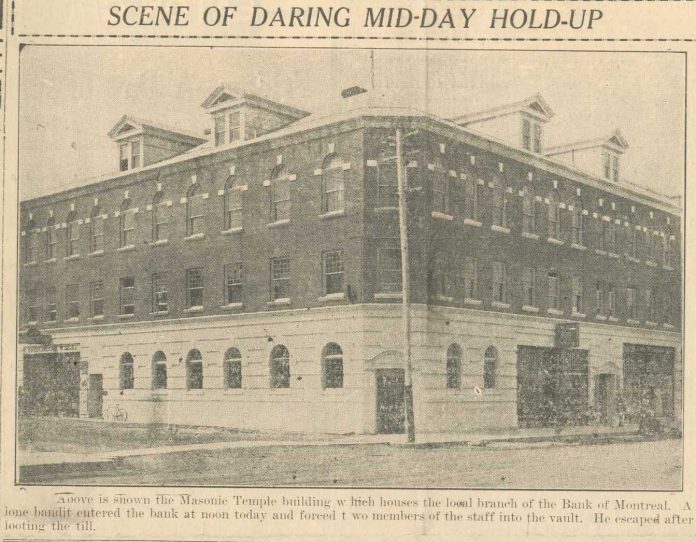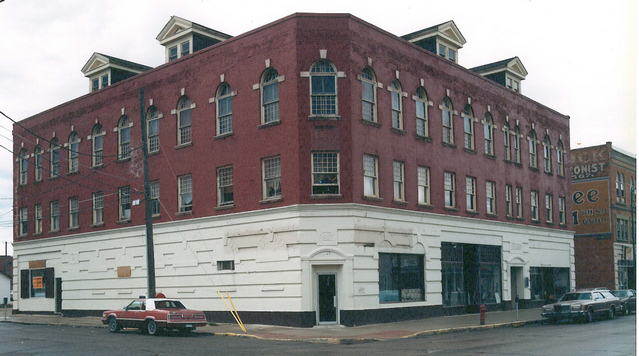
Prince Albert Historical Society
Canada’s oldest bank, the Bank of Montreal (originally established in 1817 as Montreal Bank), opened its first branch in the City of Prince Albert on Feb. 25, 1913. At that time, its premises were in the Empress Theatre building, located on First Avenue West between 11th and 12th Streets. In 1917, the bank relocated to the Masonic Temple building at 25 – 10th Street West, again in rented premises. This was its location when the bank became the victim of what was publicised at the time as “the most daring daylight robbery ever staged in Northern Saskatchewan”.

The Masonic Lodge building, shown here in the mid-1970s, housed the Bank of Montreal when an armed robbery occurred on March 15, 1928.
The robbery, which occurred shortly after noon on Thursday, March 15, 1928, was perpetrated by a lone gunman. Armed with a revolver, he entered the bank on 10th Street West, demanded to know if there was any money in the vault and, receiving a negative response, ordered both the teller and the ledger-keeper into the vault. He then proceeded to remove a considerable sum of money from the teller’s drawer, and made his escape when he was interrupted by the return of the bank’s junior clerk, who had been out having his lunch.
Information obtained from the teller, Leo Reger, and the ledger-keeper, Norman McLeod, indicated that the robber was short, that he wore a grey cap, a dark grey mackinaw coat, and a brown knitted scarf which partially covered his face. They also indicated that he appeared literate, and spoke good English. As he had jumped over the barrier separating the customer area from the employees’ working space, he was also considered to be athletic.
Both Reger and McLeod felt that the robber had a kind heart, as before leaving the bank he asked for the name of the bank manager and his telephone number in order that contact might be made to ensure their release from the vault.
Otto Taylor, the returning junior clerk, had found the bank’s door locked. He believed that someone had accidentally latched the door, and therefore used his key to unlock it. Surprising the robber as he actively gathered money from the teller’s cage, Taylor was held at gun point while the theft proceeded. As the robber fled, Taylor was able to free Reger and McLeod without problem, due to the robber’s failure to throw the bolts on the door of the vault.
Once the two employees were freed from the vault, the police were notified. However, none of the bank employees had seen the direction in which the robber had fled. This handicapped the police in their efforts to locate him.
In 1928, the year of the robbery, the City of Prince Albert was still feeling the impact of the La Colle Falls debacle. Financially, the city was in dire straights. As a result, effective March 1, 1924, the Saskatchewan Police Force had assumed responsibility for the policing of Prince Albert. Two constables of the Prince Albert police service had been transferred to the supervision of the Provincial Police, although they were still paid for by the city. As a result of this arrangement, the investigation into the armed robbery was placed in the hands of two members pf the provincial force, Sergeant R.R. Scotney and Sergeant Worgan. Scotney, in particular, previously had had a very distinguished and successful career with the force, and it was anticipated that he would soon be able to arrest the offender.
The initial step in their investigation included looking to see if there was a connection between this robbery and a previous unsuccessful attempt, a few years prior, to breach the exterior wall of the building. The police also ensured that close supervision of all rail traffic was maintained, and surrounding towns and villages were notified of the robbery and the description of the suspect.
The day after the robbery, on Friday, Mar. 16, more information regarding the robbery was released. The police, although claiming to be short-handed, indicated that they had conducted a city-wide search for the suspect but had not been able to locate him. The bank manager admitted that “over $1,000” had been stolen. A reliable source advised the Prince Albert Daily Herald that the total amount stolen was $1,600, which in today’s money would be worth approximately $28,250.
All the five and ten dollar bills, which were Bank of Montreal notes, were stolen, as well as the one and two dollar notes, which were Dominion of Canada bills. (It was not until The Bank of Canada Act, passed in 1935, that the Bank of Canada had the sole right to be the only issuer of Canadian bank notes.) The robber had also taken all the coins (50 cent, 25 cent and 5 cent) with the exception of the dimes. It was believed that Taylor’s interruption had precluded him from taking the ten cent pieces.
On this. the second day, the police had an updated description of the robber, who was now described as being 5 foot seven inches tall, dirty and dark complexioned, and wearing “a dirty green mac and dark trousers”. He appeared to have some knowledge of the bank’s routine, as he had not asked for any information regarding whether anyone else was present in the bank; nor did he search to ensure that the manager’s office was empty.
A further witness, Alexander Watling, had come forward. Watling, an employee of the CNR’s civil engineering office, had been on Avenue A on his way to the bank when he had seen the man believed to be the robber. Watling was uncertain, but he thought that the man had been walking in the direction of Central Avenue.
This new information did not appear to be of much assistance to the police. They continued to interview individuals who were deemed to be suspects, and to maintain surveillance of the railway. It was reported that over 200 men had been interviewed, including some outside the city. Tips regarding possible suspects had been received by telegraph, including from as far away as Winnipeg.
On the Monday after the armed robbery, the local detachment of the Saskatchewan Provincial Police reported that they had been receiving the full cooperation of the railways, of the city police from elsewhere in the province, and from all other Provincial Police detachments. Hundreds of suspects had been interviewed, and the local police had even taken Reger and McLeod to Saskatoon over the weekend to determine whether an individual there might be the man who had robbed the bank. Still, after all their efforts, the police were no closer to making an arrest.
The newspaper report of March 19, 1928, appears to be the last mention of the armed robbery. The media, which at that time in Prince Albert primarily consisted of the Daily Herald, appeared to lose interest when there was nothing new to report.
As of midnight, May 31 that year, the Provincial Police were dissolved, and policing in the province was taken over by the Royal Canadian Mounted Police. Prince Albert’s two municipal police officers were thereafter under the supervision and direction of the Mounties, where they remained until a decision was made a year later to re-establish the municipal force.
As for the Bank of Montreal, it soon after made its third move since opening in Prince Albert. The bank moved from 10th Street, which had limited traffic, to Central Avenue, where there was considerably more traffic and higher visibility. The new home of the bank was at 1116 Central, where Royal Lepage Icon Realty is now located.
Did the dissolution of the provincial force result in the failure of those responsible to find the man who robbed the Bank of Montreal? Or was he simply sufficiently clever, or very lucky? Whichever the answer, this case is just one more fascinating story from the history of Prince Albert and area.
Fred Payton is the president of the Prince Albert Historical Society. fgpayton@sasktel.net

